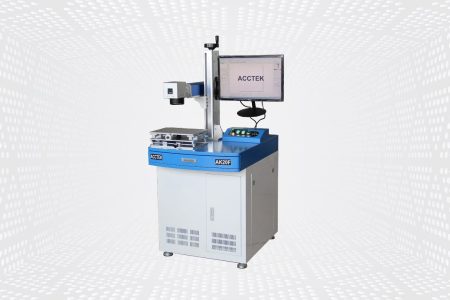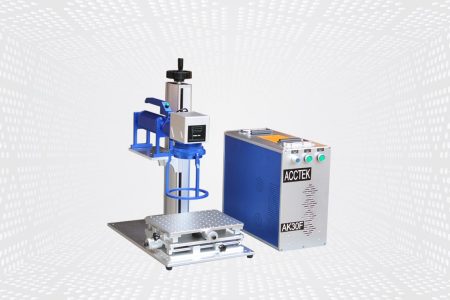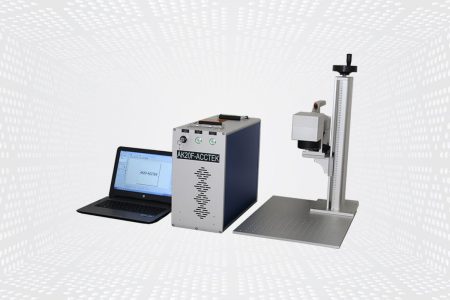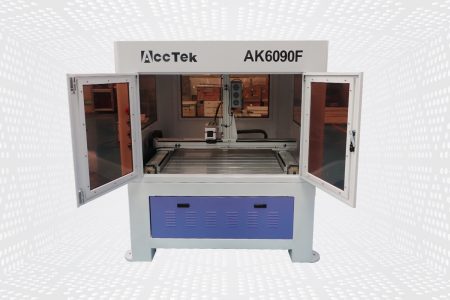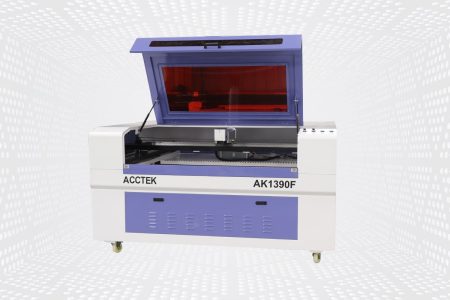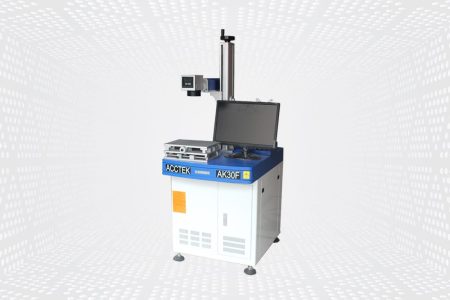Warranty
0
Years
Orders
0
+
Models
0
+
AccTek Fiber Laser Marking Machine
The fiber laser marking machine is the most popular type of laser marking machine. It uses a fiber laser generator to create high-contrast, high-quality marking laser marking equipment on a variety of materials. The fiber laser marking machine usually consists of a laser source, a beam delivery system, and a vibrating mirror. The laser source generates a high-intensity laser beam, which is transmitted through a fiber optic cable to the galvanometer, which then directs the laser beam onto the material to be marked.
The fiber laser marking machine is a machine that uses a fiber laser to mark or engrave metal, plastic, composite materials, and other materials. It is a non-contact marking technology that creates high-quality permanent marks on material surfaces and is commonly used for product identification, branding, and traceability in industrial applications.
The fiber laser marking machine has several advantages over other marking technologies, such as high speed, high precision, low maintenance requirements, and long service life. They are more environmentally friendly than other types of marking systems because they use less energy and generate less waste. The fiber laser marking machine is commonly used in industrial manufacturing because of its ability to provide high precision and speed and can produce high-quality marks that are resistant to abrasion.
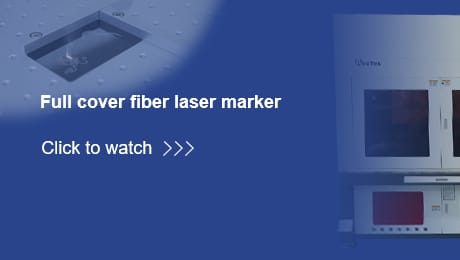
Play Video about Full Cover Fiber Laser Marking Machine
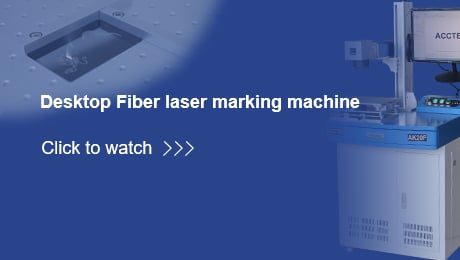
Play Video about Desktop Fiber Laser Marking Machine
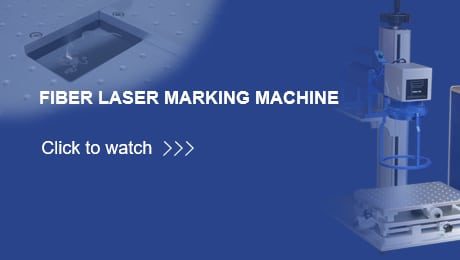
Play Video about Fiber Laser Marking Machine
Advantages of Fiber Laser Marking Machine

High Precision
High Precision
Fiber lasers offer precise marking, ensuring intricate designs and small details are accurately reproduced.

Speed and Efficiency
Speed and Efficiency
Rapid marking speeds enhance production rates, improving overall efficiency and throughput in industrial settings.

Versatility
Versatility
Capable of marking various materials, including metals and plastics, catering to diverse industrial needs.

Low Maintenance
Low Maintenance
Minimal upkeep requirements reduce downtime and operational costs, ensuring sustained productivity.

Non-Contact Process
Non-Contact Process
Marking without physical contact minimizes the risk of damage to delicate materials, ensuring quality and integrity.

Environmentally Friendly
Environmentally Friendly
Energy-efficient and waste-minimizing, fiber lasers contribute to sustainable manufacturing practices.

High Contrast and Legibility
High Contrast and Legibility
Produces clear, easy-to-read markings, facilitating accurate identification and traceability of products.

Cost-Effectiveness
Cost-Effectiveness
Despite initial investment, long-term savings accrue from reduced maintenance and operational costs.
Frequently Asked Questions
What Is a Fiber Laser Marking Machine?
The fiber laser marking machine is a type of laser marking system that uses a fiber laser to create marks, logos, patterns, or other information on a variety of materials. It operates by focusing a high-intensity laser beam onto the surface of the material, causing localized heating and altering the material’s properties to create a visible mark. Fiber lasers are preferred for their efficiency, precision, and versatility in marking various metal materials.
It is widely used in industries such as manufacturing, electronics, automotive, aerospace, medical devices, and jewelry making for applications like product identification, serial numbers, barcodes, dates, and logos. The fiber laser marking machine offers advantages such as high-speed marking, low maintenance requirements, and the ability to produce permanent, high-contrast marks with exceptional precision.
How Much Does a Fiber Laser Marking Machine Cost?
The cost of a fiber laser marking machine can vary widely depending on the specific model, features, manufacturer, and supplier. Typically, smaller, less powerful machines are less expensive than larger, more powerful machines.
On average, an entry-level fiber laser marking machine with a 20W laser costs about $2,500 to $5,000. However, higher-end models with more advanced features and larger marking areas can cost upwards of $20,000 or more. If you want to get the exact price of the fiber laser marking machine, you can contact us. AccTek engineers will provide you with the most suitable quotation for a fiber laser marking machine according to your needs and budget.
It should be noted that the purchase cost of the machine is not the only expense involved in laser marking, costs that need to be considered include installation, maintenance, and consumables such as laser marking materials. Also, important factors to consider are the quality and speed of marking, the reliability and durability of the machine, and the level of customer support offered by the manufacturer.
How Does The Fiber Laser Marking Machine Work?
Fiber laser marking machines work based on the principle of using a high-intensity laser beam to alter the surface of a material, creating a visible mark. Here’s a breakdown of the process:
- Generation of Laser Beam: The heart of a fiber laser marking machine is the fiber laser source. This source generates a high-energy laser beam typically in the infrared spectrum.
- Beam Delivery: The laser beam is guided through a series of mirrors and lenses to direct it toward the marking area. Fiber lasers are named for the optical fiber used to deliver the laser beam, which offers flexibility and precise control.
- Focusing: The laser beam passes through a focusing lens, which concentrates the energy into a small spot size. This focused beam is crucial for achieving high-resolution marks.
- Interaction with Material: When the focused laser beam hits the surface of the material, it creates intense heat. This heat affects the material in various ways depending on its composition. For example, metals may melt or vaporize.
- Mark Creation: As the laser beam interacts with the material, it forms the desired mark by altering its surface properties. This alteration could be through engraving, ablation, foaming, annealing, or color change, depending on the specific process parameters and material properties.
- Control and Precision: The machine’s control system precisely regulates parameters such as laser power, pulse duration, and scanning speed to achieve the desired mark quality and consistency.
- Cooling and Exhaust: Fiber laser marking machines typically incorporate cooling systems to manage the heat generated by the laser source and the marked material. They also often include exhaust systems to remove any fumes or debris produced during the marking process.
- Automation and Integration: Many fiber laser marking machines are equipped with computer numerical control (CNC) systems, allowing for automated marking processes. They can also integrate with other manufacturing systems for seamless production line integration.
What Is The Difference Between CO2 Lasers And Fiber Lasers?
CO2 lasers and fiber lasers are both types of laser systems used for various industrial applications, including cutting, engraving, welding, and marking. While they operate on similar principles of using laser energy to process materials, they differ in several key aspects:
- Laser Medium
- CO2 Lasers: CO2 lasers use a gas mixture, typically consisting of carbon dioxide, nitrogen, and helium, as the laser medium. The lasing action occurs within a sealed tube filled with this gas mixture.
- Fiber Lasers: Fiber lasers use a solid-state laser medium, usually a doped fiber optic cable. The lasing material is typically ytterbium, erbium, or a combination of rare earth elements embedded in the fiber core.
- Wavelength
- CO2 Lasers: CO2 lasers emit infrared light at a wavelength of around 10.6 micrometers. This wavelength is well-suited for processing organic materials like wood, paper, plastics, fabrics, and some metals.
- Fiber Lasers: Fiber lasers emit light at a wavelength typically around 1 micrometer. This wavelength is particularly effective for processing metals, including steel, aluminum, brass, copper, and alloys, as well as some plastics and ceramics.
- Energy Efficiency
- CO2 Lasers: CO2 lasers are less energy-efficient compared to fiber lasers. They require higher electrical power consumption and generate more heat during operation.
- Fiber Lasers: Fiber lasers are more energy-efficient, with higher wall-plug efficiency. They require less electrical power and generate less heat, making them suitable for continuous operation and reducing operating costs.
- Maintenance
- CO2 Lasers: CO2 lasers typically require more maintenance due to the complexity of their gas-filled tubes, which may degrade over time and require replacement.
- Fiber Lasers: Fiber lasers generally require less maintenance because they have fewer moving parts and a solid-state design. The fiber laser’s longevity is typically higher compared to CO2 lasers.
- Marking and Cutting Capabilities
- CO2 Lasers: CO2 lasers are well-suited for cutting and engraving organic materials such as wood, paper, fabric, and plastics. They can also mark certain metals using specialized coatings.
- Fiber Lasers: Fiber lasers excel at marking and cutting metals and metal alloys, including steel, aluminum, brass, copper, and titanium. They can achieve high-quality, high-contrast marks on metals without the need for additional coatings.
What Are The Disadvantages of Fiber Laser Marking?
While fiber laser marking offers numerous advantages, it’s important to consider its limitations and potential disadvantages:
- Material Limitations: While fiber lasers excel at marking metals and certain plastics, they may not be as effective for marking some non-metallic materials or materials with highly reflective surfaces. In such cases, additional surface preparation or coatings may be required to achieve satisfactory marking results.
- Initial Cost: Fiber laser marking machines can have higher initial costs compared to other marking technologies, such as CO2 lasers or inkjet printers. The investment in a fiber laser system may be substantial, particularly for small businesses or those with limited budgets.
- Complexity of Setup: Setting up a fiber laser marking system requires expertise in laser technology and material processing. Calibration of parameters such as laser power, scanning speed, and focal length is critical to achieving optimal marking results. This complexity may pose challenges for users who are not familiar with laser technology.
- Maintenance Requirements: While fiber lasers generally require less maintenance than other types of lasers, they still require periodic servicing and upkeep to ensure optimal performance. Maintenance tasks may include cleaning optical components, aligning laser beams, and replacing consumable parts such as lenses or protective windows.
- Safety Considerations: Fiber laser systems emit high-intensity laser beams that can cause eye injury or skin burns if not properly controlled. Operators must adhere to strict safety protocols, including wearing appropriate protective eyewear and clothing, and ensuring that the work area is properly enclosed to prevent exposure to laser radiation.
- Limited Depth of Marking: Fiber lasers are primarily surface marking tools and may have limitations in marking deep into certain materials. While they can create precise surface marks, they may not be suitable for applications requiring deep engraving or volumetric marking.
- Environmental Impact: Like all industrial processes, laser marking generates waste in the form of fumes, dust, and debris. Proper ventilation and exhaust systems are necessary to remove these byproducts and maintain a safe working environment. Additionally, disposal of waste materials may pose environmental concerns and require proper handling.
Do Fiber Lasers Lose Power Over Time?
Yes, like any laser system, fiber lasers can experience a gradual decrease in power over time, although the rate of power loss and the factors contributing to it can vary. Here are some reasons why fiber lasers may lose power over time:
- Laser Diode Degradation: Fiber lasers often use laser diodes as pump sources to excite the lasing medium (e.g., ytterbium or erbium-doped fibers). Over time, these laser diodes can degrade due to factors such as usage, temperature variations, and manufacturing imperfections. As the diodes degrade, they may become less efficient at converting electrical energy into laser light, leading to a reduction in laser output power.
- Fiber Damage: The optical fibers used in fiber lasers are subject to various forms of degradation, including photodarkening, fiber end-face contamination, and mechanical stress. These factors can cause light absorption and scattering within the fiber, reducing the efficiency of light transmission and ultimately leading to a decrease in laser output power.
- Optical Component Degradation: Other optical components within the laser cavity, such as mirrors, lenses, and isolators, can also degrade over time due to factors like contamination, thermal cycling, and laser-induced damage. Degradation of these components can lead to increased optical losses and reduced laser output power.
- Thermal Effects: Fiber lasers generate heat during operation, and excessive heat buildup can cause thermal damage to laser components, particularly in high-power systems. Thermal cycling and temperature fluctuations can accelerate degradation processes and contribute to a decline in laser performance over time.
- Contamination: Contaminants such as dust, dirt, or particulate matter can accumulate on optical surfaces within the laser system, leading to increased optical losses and reduced laser output power. Regular cleaning and maintenance of optical components maintain laser performance.
What Materials Can The Fiber Laser Marking Machine Mark?
Fiber laser marking machines are highly versatile and can mark a wide range of materials, including:
- Metals: Fiber lasers are particularly well-suited for marking metals and metal alloys due to their high power density and precise control. Commonly marked metals include stainless steel, aluminum, brass, copper, titanium, gold, silver, and various alloys used in automotive, aerospace, jewelry, and medical device industries.
- Plastics: Fiber lasers can mark various types of plastics, including ABS, PVC, acrylic, polycarbonate, polyethylene, polypropylene, and nylon. They can create high-contrast, permanent marks on plastic components used in electronics, consumer goods, packaging, and automotive applications.
- Organic Materials: Fiber lasers can mark organic materials such as wood, paper, cardboard, leather, and fabrics. They are often used for engraving, branding, and labeling on wooden products, packaging, textiles, and leather goods.
- Coated Materials: Fiber lasers can mark materials that have been coated with specialized marking coatings or surface treatments. These coatings are designed to enhance contrast, improve adhesion, or provide additional protection against abrasion or corrosion.
How Precise Are The Markings Produced By The Fiber Laser Marking Machine?
The precision of markings produced by a fiber laser marking machine is exceptionally high, often achieving sub-millimeter accuracy and sharpness. Several factors contribute to this precision:
- Beam Quality: Fiber lasers typically produce a high-quality laser beam with a small spot size and excellent beam divergence characteristics. This allows for precise focusing and control of the laser energy onto the marking surface, resulting in fine details and sharp edges in the markings.
- Optical Systems: Fiber laser marking machines are equipped with advanced optical systems, including high-quality lenses, mirrors, and galvanometer scanners. These components enable precise beam control, rapid scanning speeds, and accurate positioning, ensuring that markings are placed exactly where intended with minimal deviation.
- Control Software: Modern fiber laser marking machines are driven by sophisticated control software that allows users to define and adjust marking parameters with precision. This software enables precise control over laser power, pulse duration, marking speed, and other parameters, allowing for optimal customization of marking processes for different materials and applications.
- Mechanical Stability: The mechanical stability of the marking system, including the rigidity of the machine structure and the stability of motion control systems, is crucial for achieving precise markings. High-quality machines are designed to minimize vibrations and mechanical distortions that could affect marking accuracy.
- Material Compatibility: Fiber laser marking machines are capable of marking a wide range of materials, including metals, plastics, ceramics, and organic materials. The versatility of these machines allows for precise markings on diverse materials with varying surface properties and compositions.
- Resolution and Linearity: Fiber laser marking systems typically offer high resolution and linearity, allowing for the creation of intricate designs, small text, and complex patterns with precise control over line thickness and spacing.
Get Laser Solutions
We can customize the design according to your requirements. You only need to tell us your requirements, and our engineers will provide you with turnkey solutions in the shortest possible time. Our laser equipment prices are very competitive, please contact us for a free quote. If you need other laser equipment-related services, you can also contact us.

